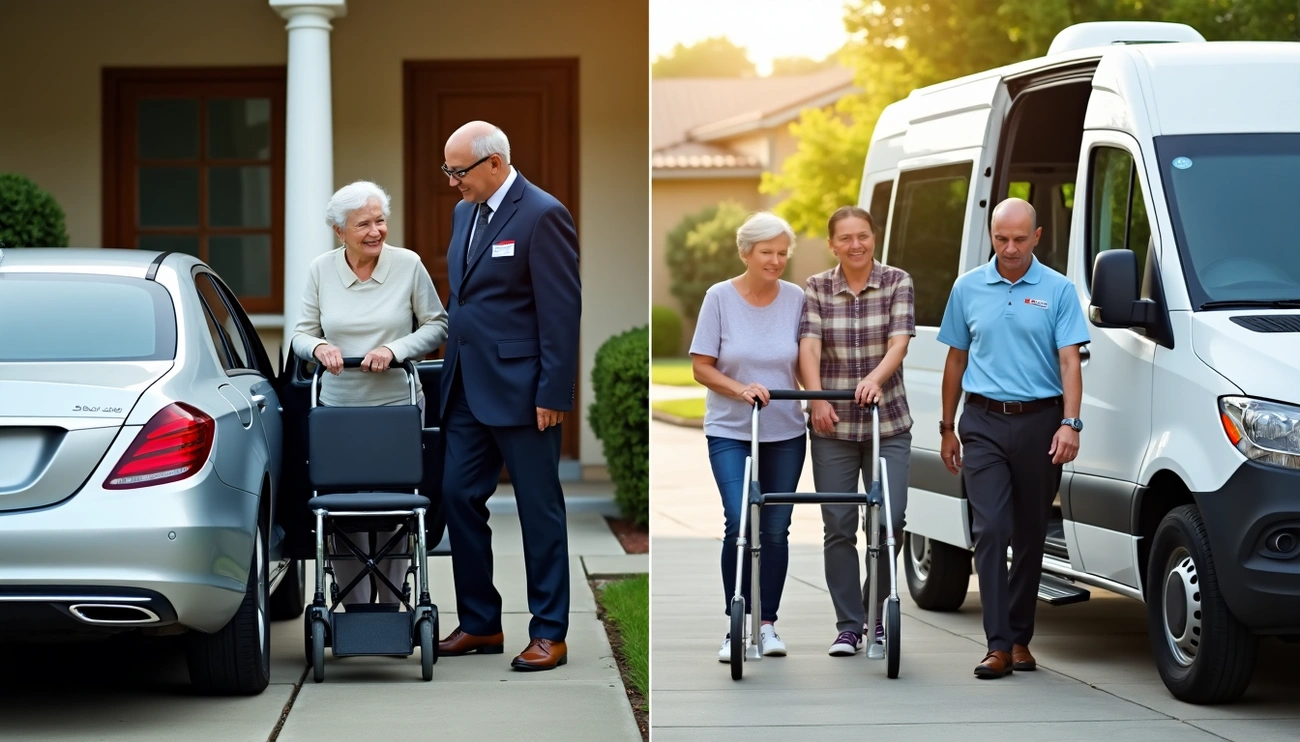When comparing private transportation services for seniors with shared options, we’re addressing a critical need for approximately 600,000 older adults who give up driving each year. Without reliable transportation, seniors face significant challenges attending medical appointments, shopping, and social events – activities essential for maintaining independence and quality of life.
Half of Americans aged 65 and older don’t have access to public transportation, and more than half of non-drivers in this age group stay home on a given day specifically due to lack of transportation. Consequently, transportation options for seniors have become increasingly important. Three-quarters of caregivers list providing or arranging transport as one of their primary responsibilities, highlighting just how essential reliable driving services for seniors truly are. Whether considering specialized door-through-door assistance or community-based shuttle programs, the best ride service for seniors depends on individual needs, location, and financial considerations.
Throughout this guide, we’ll examine how senior transportation services differ in terms of care level, cost, accessibility, and practical applications to help you make an informed decision that balances independence with appropriate support.
Types of Senior Transportation: Private vs Shared
Senior transportation options generally fall into two main categories: private and shared services, each offering distinct advantages for different needs and circumstances.
Private Options: Door-through-door and concierge services
Private transportation services for seniors offer personalized support that extends beyond simply driving from point A to point B. Unlike standard transportation, door-through-door services provide comprehensive assistance from inside the senior’s home, through the vehicle journey, and into their final destination. This includes help getting out of bed, assistance walking to the vehicle, and support entering buildings like doctor’s offices.
Concierge transportation services typically include waiting services and companionship during appointments. Drivers assist with grocery shopping, carrying purchases, and can accompany seniors during errands or social outings. These services essentially function as both transportation provider and temporary companion.
Companies like GoGoGrandparent connect seniors with ride services from Uber and Lyft without requiring a smartphone, offering monitoring and notifications for family members. SilverRide provides drivers specifically trained to address seniors’ unique needs, including physical support and emergency response capabilities.
Most private ride services charge between $20-$40 per trip, though some specialty services may calculate fares by mile or zone. While more expensive than shared options, these services provide flexibility with on-demand or same-day scheduling in many cases.
Shared Options: Paratransit, community shuttles, and ride-pooling
Shared transportation includes several cost-effective alternatives that still cater to seniors’ needs:
Paratransit services operate under the Americans with Disabilities Act (ADA), requiring public transit agencies to provide complementary services for those unable to use standard public transportation. These services must be available within 3/4 mile of bus routes or rail stations and charge no more than twice the standard fare. While offering accessibility features like wheelchair lifts, paratransit typically provides curb-to-curb rather than door-to-door assistance.
Community shuttles and volunteer programs operate in many areas through senior centers, religious organizations, and county agencies. These programs often provide free or low-cost transportation to medical appointments, grocery stores, pharmacies, and senior centers. In some regions, these programs offer door-to-door service with trained volunteer drivers.
Ride-pooling options allow multiple seniors traveling in similar directions to share transportation costs. Many county and municipal dial-a-ride programs operate on this model, picking up several passengers along routes.
Most shared transportation options require advance scheduling—typically 24-72 hours—and operate on fixed schedules with limited flexibility. However, they offer significant cost savings through subsidized rates, Medicaid coverage for eligible medical transportation, and volunteer-based services.
The appropriate choice between private and shared transportation ultimately depends on the senior’s mobility level, budget constraints, advance planning ability, and geographic location.

Level of Care and Assistance Provided
The care level provided by different senior transportation options significantly impacts both safety and comfort for older adults. Professional assistance varies dramatically between service types, affecting everything from physical support to medical care capabilities.
Physical Assistance: Door-to-door vs curbside support
Door-to-door service represents a comprehensive approach where drivers enter the senior’s residence, help them navigate to the vehicle, and ensure they reach their destination safely. This contrasts sharply with curbside pickup, which requires seniors to exit their homes independently and wait at the curb—potentially dangerous in winter months with slippery walkways.
For wheelchair users and those with limited mobility, the distinction becomes even more critical. Door-to-door providers are typically trained in proper wheelchair transfers, which must be performed by professionals or family members familiar with proper techniques. Additionally, door-to-door service often includes assistance with bags, loading wheelchairs, and carrying purchases—support that’s absent in basic curbside options.
Medical Needs: NEMT vs standard shared rides
Non-Emergency Medical Transportation (NEMT) offers specialized support for seniors with medical requirements. These services, incorporated into Medicaid since 1966, provide transportation to treatments, testing, and health-related appointments. NEMT vehicles come equipped for medical necessities, featuring wheelchair ramps, comfortable seating designed for patients, and emergency supplies onboard.
Moreover, NEMT providers accommodate complex medical needs such as oxygen tanks and can offer additional assistance like accompanying clients to doctor’s appointments. This level of support stands in stark contrast to standard shared rides, which typically lack medical training or equipment. According to a survey by the National Association of NEMT Providers, 95% of member companies require specialized training for drivers providing door-to-door service.
Driver Training: Professional caregivers vs general drivers
The training gap between professional caregivers and general transportation drivers creates meaningful differences in service quality. Professional caregivers receive training in:
- Patient transfers, CPR, and first aid response
- Proper handling of mobility devices
- Emergency management techniques
- Building relationships with regular clients
Professional caregivers can provide a clean home environment, prepare meals, handle errands, and offer personalized assistance beyond transportation. Furthermore, they frequently accompany seniors throughout outings, offering companionship at grandchildren’s events or shopping trips.
In contrast, paratransit systems typically offer more limited driver support. Although drivers might help passengers board vehicles, they rarely enter homes or provide extensive personal assistance. Similarly, standard rideshare drivers have minimal training requirements compared to NEMT providers, with initiatives like Uber Assist and Lyft Assisted offering improvements but falling short of professional caregiver capabilities.
These care differences ultimately determine which transportation option best serves seniors based on their individual needs, health status, and desired independence level.
Cost and Affordability Comparison
The financial commitment required for senior transportation varies substantially across service types, creating important considerations for families weighing independence against budget constraints.
Average Cost per Trip: $20-$40 vs subsidized/shared rates
Private transportation services typically charge between $20-$40 per ride, a premium price reflecting personalized assistance and flexible scheduling. Indeed, in urban areas like Philadelphia, private senior transportation averages $19.68 per hour, with more affluent suburbs commanding rates as high as $39.29 per hour in places like Malvern, PA. This translates to approximately $787 weekly for full-time assistance.
Conversely, shared transportation options offer considerably lower rates. Paratransit services rarely exceed twice the standard public transit fare, typically under $5-$10 per ride. For instance, community-based programs like Kent County’s RideLink charge a modest $3 per one-way trip, formerly $2 before recent cost adjustments. These subsidized options prioritize affordability over convenience, particularly for fixed-income seniors.
Insurance and Medicaid Coverage: NEMT eligibility
Non-Emergency Medical Transportation (NEMT) represents a critical cost-saving option for qualifying seniors. Established alongside Medicaid in 1966, NEMT covers a wide range of services from taxis to specialized medical vans. Notably, despite its comprehensive coverage, NEMT constitutes less than 1% of total Medicaid expenditures at approximately $3 billion annually.
Original Medicare (Parts A & B) offers limited transportation benefits, primarily covering emergency ambulance services or medically necessary transport as determined by physicians. Nevertheless, after meeting the annual deductible of $257, Medicare Part B covers 80% of eligible transport costs. At this point, Medicare Advantage (Part C) plans occasionally include additional transportation benefits beyond what Original Medicare provides.
Membership Fees and Discounts: GoGoGrandparent vs public programs
Private concierge services like GoGoGrandparent utilize tiered membership models. Their plans range from Basic ($11.72/month billed annually) to Total Care ($409.99/month), with per-service fees diminishing at higher tiers. For instance, the Basic plan charges $0.27/minute plus a $5 operator fee per ride, whereas the Total Care plan includes unlimited operator-ordered rides.
Public programs offer alternative savings approaches through reduced fare initiatives. Seniors aged 60+ qualify for half-price fares on many public transportation systems, alongside specialized options like free grocery shuttle services. Volunteer driver programs typically request nominal contributions of $5-$10 per trip, substantially below market rates.
This cost disparity highlights the fundamental trade-off: private services provide comprehensive support at premium prices, whereas shared options deliver basic transportation at accessible rates.
Accessibility and Comfort Features
Accessibility features form the backbone of effective senior transportation services, determining both usability and satisfaction for older adults.
Vehicle Accessibility: Wheelchair lifts and ramps
The Americans with Disabilities Act mandates accessibility standards for public transportation, requiring wheelchair lifts on busses and accessible cars on trains. Private transportation services often surpass these minimum requirements with specialized equipment. Wheelchair-accessible vehicles typically feature:
- Side-entry or rear-entry ramps (side-entry best for seniors who will drive or ride in passenger seats)
- Manual or powered vehicle ramps (powered eliminating the need to manually deploy)
- Secure wheelchair tie-downs and restraint systems
For seniors using mobility devices, these accessibility features prove essential. Many paratransit services provide wheelchair-accessible vans that offer curb-to-curb service, meanwhile private services sometimes charge additional fees for motorized wheelchair accommodation.
Scheduling Flexibility: On-demand vs fixed routes
On-demand mobility services provide seniors enhanced accessibility to destinations, hereafter their primary reported benefit. Simultaneously, fixed-route systems operate on predetermined schedules with limited flexibility.
Private transportation services typically offer greater scheduling adaptability, including same-day booking options. Conversely, demand-response transit—representing 69% of all public transit trips in rural areas—requires advance booking, sometimes days ahead.
Senior concerns about on-demand services include the need to actively request rides, potential fare increases, and possible technology failures. To address these barriers, some services allow ride requests via telephone rather than smartphones.
Comfort and Cleanliness: Private fleets vs shared vehicles
Private transportation services prioritize comfort through:
- Spacious interiors with adjustable seating
- Climate control systems maintaining consistent temperatures
- Low steps and handrails for easier entry/exit
Afterward, rider experience often differs between service types. Private fleets typically maintain higher cleanliness standards with regular sanitization. Furthermore, some specialized vehicles feature vinyl or antimicrobial materials facilitating easier cleaning.
Door-through-door services offer three distinct service levels: curb-to-curb (pickup at curb), door-to-door (assistance to/from door), and person-to-person (complete escort service with handoff to responsible party).
Best Use Cases for Each Option
Matching seniors with the right transportation option requires understanding each service’s strengths for specific situations and needs.
Private Rides: Medical appointments and high-assistance needs
Private transportation services for seniors excel in healthcare contexts, providing critical support for medical appointments and health-related visits. For cancer patients requiring frequent treatments – sometimes three times weekly – private rides offer the consistency and reliability essential for aggressive treatment plans. These services prove invaluable for seniors with complex medical conditions who require assistance beyond basic transportation.
Door-through-door support particularly benefits seniors with limited mobility, offering comprehensive assistance from home to destination. Private services typically include help getting from residences to vehicles, entering and exiting transportation, and navigating through the destination’s entrance. This level of care becomes vital for those requiring specialized mobility equipment or personal assistance with daily activities.
Shared Rides: Social outings and errands
Shared transportation options thrive as solutions for maintaining social connections and independence. Subsequently, community-based programs help seniors avoid isolation by facilitating access to senior centers, family events, and leisure activities. Many older adults hesitate to request “non-essential” rides from family caregivers despite these activities being crucial for mental wellbeing.
For routine errands like grocery shopping and pharmacy visits, shared transportation provides cost-effective solutions. Approximately 40% of rural seniors’ personal driving trips involve shopping and errands, making accessible transportation for these activities a priority. Community shuttles typically schedule regular routes to popular destinations, enabling seniors to maintain independence in daily tasks.
Urban vs Rural Availability
Transportation access varies dramatically between urban and rural settings:
- Only 33% of rural areas have public transportation compared to 75% of metropolitan areas
- Rural seniors face unique barriers regarding service hours, coverage areas, and accessibility
- Only about 25% of personal banking sites, grocery stores, and healthcare services are accessible on rural public transportation routes
Regardless of location, the best transportation choice ultimately depends on individual mobility needs, financial resources, and geographical constraints.
Comparison Table
| Feature | Private Transportation | Shared Transportation |
|---|---|---|
| Average Cost | $20-$40 per trip | $5-$10 per trip (paratransit) $3-$5 for community shuttles |
| Level of Assistance | Door-through-door service Help with groceries/packages Companionship during appointments | Curb-to-curb service Limited personal assistance Basic boarding help |
| Driver Training | – CPR and first aid certified – Patient transfer training – Emergency management – Mobility device handling | Basic training Limited medical knowledge Minimal support requirements |
| Scheduling | On-demand or same-day booking Flexible scheduling | 24-72 hours advance booking Fixed routes and schedules |
| Accessibility Features | – Wheelchair lifts/ramps – Specialized equipment – Comfortable seating – Personal assistance | – Basic wheelchair accessibility – ADA-compliant features – Standard vehicle amenities |
| Insurance Coverage | May be covered by Medicare Advantage Some private insurance plans | Medicaid NEMT coverage Subsidized rates available |
| Best Use Cases | – Medical appointments – High-assistance needs – Complex medical conditions – Personal errands | – Social outings – Group activities – Regular shopping trips – Local community events |
Conclusion
Choosing between private and shared transportation ultimately depends on balancing a senior’s need for assistance with budget constraints. Although private services command higher prices ranging from $20-$40 per trip, they deliver comprehensive door-through-door support essential for those with limited mobility or complex medical conditions. Shared options certainly offer financial advantages at $3-$10 per ride while still providing basic transportation to key destinations.
The accessibility gap between urban and rural communities creates additional challenges, with approximately 50% of Americans 65+ lacking access to public transportation. This reality makes transportation planning even more crucial for families supporting aging loved ones. Additionally, driver training represents a significant differentiator between service types—professional caregivers typically receive specialized training in transfers, first aid, and mobility device handling that standard drivers lack.
Scheduling flexibility presents another important consideration. Private services typically accommodate same-day requests, whereas shared options generally require advance booking of 24-72 hours. Therefore, seniors with unpredictable schedules or frequent medical appointments might benefit more from private transportation despite higher costs.
The transportation option that best serves a senior ultimately depends on their specific mobility needs, financial resources, and geographic location. Families should evaluate each senior’s situation individually, weighing independence against safety concerns while considering which destinations matter most for maintaining quality of life. Taking time to research available options in your specific community will help ensure that transportation enhances rather than limits an older adult’s independence and wellbeing.

FAQs
Q1. What are the main differences between private and shared senior transportation services? Private services offer personalized door-through-door assistance and flexible scheduling, typically costing $20-$40 per trip. Shared options like paratransit and community shuttles provide more affordable transportation at $3-$10 per ride but with less individualized support and fixed schedules.
Q2. How does the level of care differ between private and shared transportation for seniors? Private services often provide comprehensive care with drivers trained in first aid, patient transfers, and mobility device handling. They offer door-through-door assistance and can accompany seniors during appointments. Shared services generally offer more basic curb-to-curb support with limited personal assistance.
Q3. Are there any financial assistance options available for senior transportation? Yes, there are several options. Medicaid covers Non-Emergency Medical Transportation (NEMT) for eligible seniors. Some Medicare Advantage plans include transportation benefits. Additionally, many public transit systems offer reduced fares for seniors, and some community programs provide low-cost or free rides.
Q4. What accessibility features are important in senior transportation vehicles? Key features include wheelchair lifts or ramps, secure tie-downs for mobility devices, spacious interiors with adjustable seating, and easy-to-use handrails. Private services often have more specialized equipment, while shared options typically meet basic ADA compliance standards.
Q5. How do urban and rural areas differ in terms of senior transportation availability? Urban areas generally have more diverse transportation options, with 75% of metropolitan areas offering public transit. Rural areas face greater challenges, with only 33% having public transportation. Rural seniors often have limited access to services, with only about 25% of essential locations like banks and healthcare facilities accessible via public transit routes.












